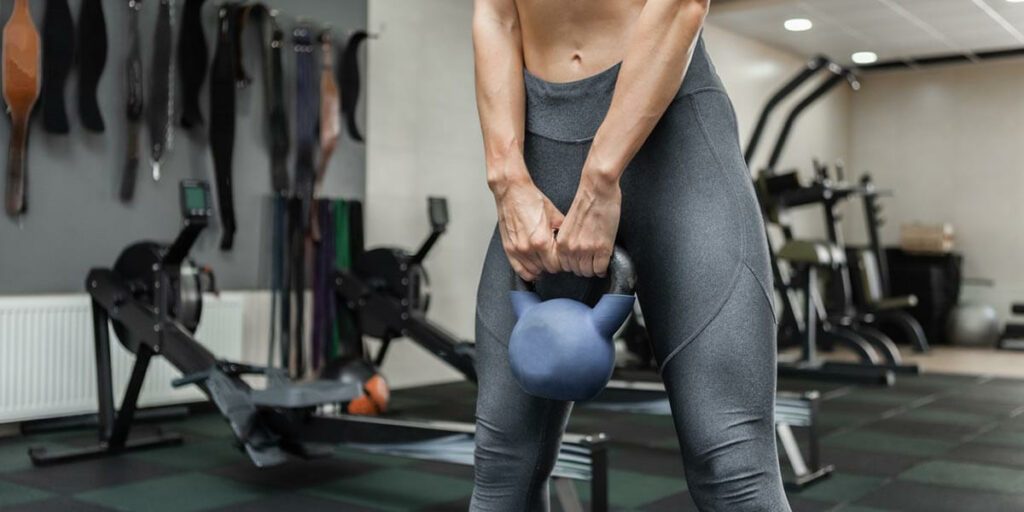
Summary
Welcome / Welcome / Tips for getting started / Cardio circuit training: optimise your endurance and strength
Cardio circuit training: optimise your endurance and strength
Cardio circuit training is the perfect way to boost your cardio, burn calories and build endurance, while maximising every minute. Whether you're a beginner or a seasoned athlete, this method offers simple, effective exercises adapted to your pace, with no need for special equipment.
In this article, discover the benefits of cardio circuit training, examples of essential movements, and circuits adapted to each level to optimise your physical condition. Looking for a fast, intense cardio routine that fits in with your schedule? Then this complete guide is for you!
Summary
What is cardio circuit training?
Definition and principle
THE cardio training circuit is a training method that combines a variety of cardio exercises, performed continuously with little or no rest between movements. This type of circuit helps to maintain a high heart rate, which maximises calorie expenditure and boosts endurance. The idea is to create a sequence of simple but intense exercises to challenge the cardiovascular system and work the whole body in as little time as possible.
This approach is particularly suited to those with a tight schedule who want maximum results in a short space of time. Just imagine: you can do an effective session in 20 minutes, whether in the morning before heading to the office or during your lunch break. For young professionals, it's an opportunity to look after their fitness without compromising their busy schedule.
Difference between circuit training and other methods (HIIT, Tabata)
Although similar, circuit training and other methods such as the HIIT (high-intensity interval training) or the Tabata are distinguished by their objectives and structure. In circuit training, the emphasis is on continuity and variety of exercises, often without breaks, to keep the heart rate constant. HIIT and Tabata, on the other hand, include specific rest phases between intervals of very intense exercise.
In other words, the HIIT focuses on explosiveness and short breaks to develop muscular power and endurance. As for TabataThis is an ultra-short 4-minute format that alternates 20 seconds of effort with 10 seconds of rest, perfect for working on speed and stamina in the blink of an eye. Cardio circuit training, on the other hand, is more flexible and accessible, allowing you to modulate the exercises and duration according to your needs and level.
The benefits of cardio circuit training
Cardiovascular health benefits
Cardio circuit training is a great way to strengthen your cardiovascular system. By gradually increasing your heart rate, it promotes better blood circulation and improves your heart's ability to pump blood. By exercising regularly, you reduce the risk of high blood pressure and heart disease. It's like regular maintenance for your internal engine: you gain endurance and stamina in the face of prolonged exertion, whether you're going for a run or simply climbing the stairs without getting out of breath!
Weight loss benefits
Cardio circuit training is also extremely effective for burning calories. Thanks to its intensity, it activates the metabolism even after the session, which is known as the "afterburner effect". afterburn effect. In other words, your body continues to consume energy to recover, and this can last for several hours after training. For those looking to lose weight or slim down, circuit training is an ideal method because it combines muscular work with intense energy expenditure.
Improving overall fitness
By varying the exercises, cardio circuit training not only stimulates the heart and burns fat, it also works numerous muscle groups. In this way, it strengthens the arms, legs, abdominal muscles and even the back. This type of routine makes your body more functional, i.e. better prepared for everyday efforts. A circuit training session can improve your posture, coordination and even balance. In short, you gain in agility and strength, while enjoying a harmonious, toned physique.
Essential cardio circuit training exercises
Cardio circuit training is based on simple but intense exercises that work both the heart and the muscles. Here are a few key movements, along with advice on how to perform them to best effect
These exercises are perfect for getting your heart rate up quickly and working your whole body. Classic cardio exercises are the basis of circuit training, as they stimulate the cardiovascular system and increase endurance.
It's important to maintain a steady pace to get the maximum benefit from these exercises. Aim for a moderate to high intensity, depending on your level, and adjust the duration according to your endurance.
Burpees
Benefits of the exercise
THE burpees are a complete exercise that combines muscle strengthening and cardio, involving both the upper and lower body. They strengthen the arms, legs and core, and also mobilise the stabilising muscles. Burpees rapidly increase heart rate, making them an excellent choice for improving endurance and burning maximum calories in a short space of time. By adding explosive movements, they also develop power and coordination, making burpees a perfect exercise for intense cardio circuits.
How to do it
Start by standing with your feet slightly apart. Squat down with your hands on the floor in front of you, then jump back into a plank position, abs tight and back straight. Perform a push-up by bending your elbows to lower your chest towards the ground, then push off to return to a plank. Then jump towards your hands to return to the squat position and finish by jumping into the air with your arms raised. To maximise the effects, maintain a steady rhythm and fluid execution while maintaining good posture.
Jumping Jacks
Benefits of the exercise
Jumping jacks are simple, effective and accessible, ideal for rapidly stimulating cardio and increasing heart rate. This exercise works the muscles of the arms, legs and trunk, building muscular endurance and agility. Thanks to the jumping movements, jumping jacks activate blood circulation, helping to burn calories in a short space of time. It's a perfect option for warming up or incorporating into a cardio circuit to add intensity without the need for equipment.
How to do it
Start standing with your feet together and your arms at your sides. Jump up by simultaneously spreading your arms and legs until you form an "X" with your body, then quickly return to the initial position. To maximise the cardiovascular effects, keep up a steady rhythm while maintaining regular breathing. Concentrate on fast, fluid movements, taking care not to bend your knees too much.
Mountain Climbers
Benefits of the exercise
Mountain climbers are a complete cardio exercise, ideal for improving endurance and core stability. They work the heart and strengthen the legs, shoulders and abdominal muscles. It's a movement that intensifies the heart rate quickly, while working several muscle groups, perfect for functional training. Mountain climbers also help to improve coordination and agility, essential qualities for sporting activities and everyday tasks.
How to do it
Start in a plank position, arms outstretched, hands well aligned under the shoulders. Keep your body straight, contract your abdominal muscles and bring one knee towards your chest while keeping your hips stable. Then return the leg to its initial position, and repeat the movement with the other knee at a fast pace. Make sure you keep a steady pace without compromising back stability, and avoid lifting your hips to maximise the effectiveness of the exercise.
Jumping rope
Benefits of the exercise
A classic exercise, skipping rope is ideal for cardio and improves coordination. In just a few minutes of skipping rope, you can achieve an expenditure similar to that of a twenty-minute jog.
Whether you're looking to improve your cardio or lose weight, skipping rope is a must. Don't worry: with skipping rope, you'll progress very quickly!
How to do it
Jump in rhythm, keeping your wrists relaxed. Vary the intensity according to your level and try to maintain a steady tempo to maximise endurance.
If you want to go further, discover even more techniques for jumping rope to vary your workouts.
Dynamic squats
Benefits of the exercise
Dynamic squats are perfect for strengthening the legs and glutes while adding a cardio dimension to your workout. This move engages the major leg muscles, including the quadriceps, hamstrings and calves, while also working the abdominals to stabilise the body. By adding a jump, this squat becomes a plyometric exercise that improves explosiveness, coordination and muscular endurance. It's an ideal exercise for toning the lower body and burning calories quickly.
How to do it
Start standing, feet hip-width apart, abs engaged. Lower into a squat by bending your knees and pushing your hips back until your thighs are parallel to the floor. Make sure your knees stay in line with your feet. Next, push firmly into your heels to jump slightly into the air and return to the squat position with a soft landing. Maintain a smooth, controlled rhythm for each repetition, avoiding long pauses between jumps to maximise the cardio effect.
Jumped lunges
Benefits of the exercise
THE slots Jumping jacks are a dynamic and intense exercise that work the muscles of the legs and buttocks, while increasing the heart rate. This movement engages the quadriceps, hamstrings and glutes, strengthening and toning the lower body. By adding a jump between each lunge, this exercise also works on explosiveness and coordination, improving stability and balance. It's a great option for burning calories and adding a cardio challenge to your strength training routine.
How to do it
Start in a lunge position, with one leg in front and the other behind, both knees bent. Pushing down hard on both legs, jump into the air and reverse the position of your legs to land in the opposite lunge. Make sure you keep your torso upright and bend both knees to absorb the impact gently and protect your joints. Maintain a fluid, controlled rhythm to maximise cardio efficiency and reduce the risk of injury. Concentrate on powerful, fast movements for each repetition.
Examples of suitable cardio training circuits
Circuit for beginners
- Example circuit:
- 30 seconds of jumping jacks
- 30 seconds of squats
- 30 seconds of mountain climbers
- 1 minute pauserepeat 3 times
Intermediate circuit
- Example circuit:
- 45 seconds of burpees
- 45 seconds of dynamic lunges
- 30 seconds of jump rope
- 30-second pauserepeat 4 times
Advanced circuit
- Example circuit:
- 1 minute of burpees with a high jump
- 1 minute sprint on the spot
- 45 seconds of fast push-ups
- 20-second pauserepeat 5 times
Tips for maximising the effectiveness of your cardio circuit training
Warming up and stretching properly
A warm-up is essential to prepare your muscles and joints. Take 5 to 10 minutes to gradually increase your heart rate. Always finish with gentle stretching to reduce muscle soreness.
Adapting the tour to your level
Choose suitable exercises and adjust the intensity according to your ability. You can gradually increase the difficulty by adding repetitions or reducing the number of breaks.
Hydration and the right diet
Hydrate before, during and after your session. After training, consume a source of carbohydrates and protein to help muscle recovery.
Vary the exercises to progress
Your body adapts to repeated efforts, so it's important to diversify your exercises to avoid stagnation. Change your movements, intensity and duration to challenge your muscles and cardio in different ways. For example, switch from dynamic squats to jumping squats, or incorporate exercises with elastic bands for added resistance. By renewing your circuits, you can maintain your motivation and continue to make progress.
Conclusion
Cardio circuit training is a powerful workout that combines cardio exercise and muscle strengthening for improved fitness. In this guide, you'll find information on the benefits of circuit training, examples of exercises suitable for different fitness levels, and advice on how to get the most out of it. By incorporating circuit training into your routine, you can boost your stamina and well-being while maximising your time.
Want to take your training further? Check out our articles on the best HIIT techniques and other cardio exercises. You'll find methods for varying your routine and optimising your results, adapted to your busy schedule!
Try out DRIP's intense circuit training
Ready to get moving? We've got you covered! Come and discover DRIP with 45 minutes of intensive training, inspired by circuit training and HIIT.
Do one workshop after another without a break to maximise your calorie burn, in a supercharged atmosphere, with our passionate coaches and exclusive playlists.
Our mission? To motivate you to excel, with a smile on your face! Take advantage of a friendly environment to let off steam without restraint.
Everyone is welcome at DRIP, whether you're an experienced sportsman or a beginner - our studio is made for you!
If you are preparing a HYROX race, we offer HYROX special trainings in our studios!
Ready to work up a sweat? Head for the 8th arrondissement, near Monceau, or Grands Boulevards. You'll love the challenge! ❤️🔥
Share
Tagged
Read also
follow us
on instagram
To follow all our news,
take advantage of our tutorials and participate
in our many competitions.
BREAKING NEWS!
Receive our newsletter.



